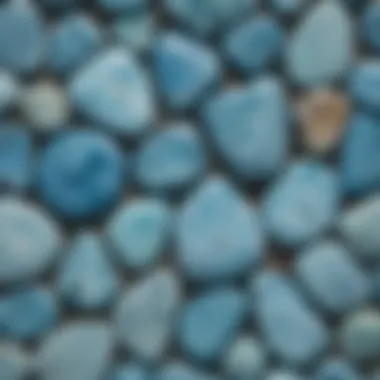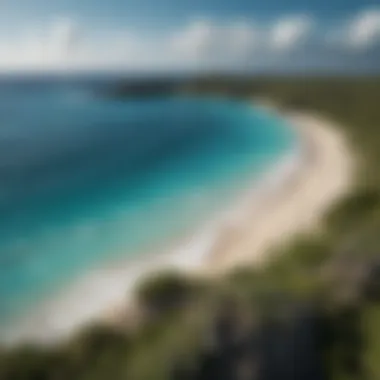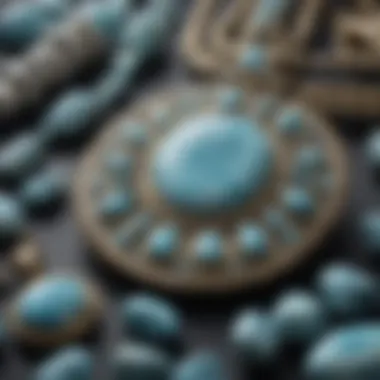Discovering the Allure of Caribbean Larimar Gemstone


Intro
Caribbean larimar is a stunning gemstone found in the Dominican Republic. Its captivating blue color, reminiscent of the ocean, makes it a unique addition to the collection of any rock or mineral enthusiast. This article will explore various facets of larimar, including its geological formation and cultural significance. We will also look at the extraction challenges faced by collectors and the environmental considerations surrounding its collection. Moreover, this discussion will include the uses of larimar in jewelry and holistic practices, providing a well-rounded perspective on this exceptional gem.
Geological Insights
Larimar is a rare variety of pectolite, formed through the geological processes involving hydrothermal activity. The mineral content of larimar reflects the natural elements found in its environment. Here are key aspects of its geological insights:
Geological Formation and Processes
The formation of larimar is tied to volcanic activity. It originates from lava flows and subsequently experiences changes due to temperature and pressure. The beautiful blue color is primarily attributed to the presence of copper ions mixed with the pectolite's crystalline structure. Understanding the geological background aids in appreciating how unique larimar is within the broader context of gemstones.
Historical Significance of Larimar
Larimar's history is not just geological but deeply cultural. It was rediscovered in the 1970s by a local Dominican named Miguel Méndez and a peace corps volunteer, Norman Rilling. After this discovery, the gemstone gained popularity thanks to its rarity and beauty. It became symbolic of the Dominican Republic's natural wealth, drawing attention to both its unique craftsmanship and the challenges of sustainable collection.
Notable Discoveries
In terms of remarkable finds in the realm of larimar, some exquisite pieces have emerged from the mining areas of the Dominican Republic. Not just in total quantity but also in purity and color, these pieces often fetch high prices on the market. Each discovery contributes to both scientific knowledge and cultural heritage surrounding the gemstone.
"Understanding larimar's geological background adds a significant layer of appreciation towards the gemstone's rarity and cultural importance."
Collecting Tips and Techniques
For those interested in starting or expanding their larimar collection, understanding the collection process is critical. It requires not only passion but also respect for the Caribbean environment. Here are practical tips for collecting larimar:
Best Practices for Collecting
- Research Locations: Familiarize yourself with authorized mines and collecting sites. The proper permits are essential in many areas.
- Be Respectful: Always adhere to environmental regulations. This ensures that larimar can continue to be collected for future generations.
- Engage with the Community: Local miners often have invaluable knowledge about collecting practices and the gem's history.
Locating Prime Collecting Sites
In the Dominican Republic, larimar is primarily gathered in the Barahona province. Areas near the Sierra de Bahoruco are particularly rich in larimar deposits. When visiting these locations, consider contacting local experts to maximize your chances of successful collection.
How to Safely Extract Specimens
When extracting larimar specimens, gentle techniques are paramount. Avoid using heavy tools that could damage the surrounding area or the gemstone itself. Instead, consider using:
- Hand tools designed for delicate excavation
- Protective gear to prevent injury
- Containers for safe transportation of collected specimens
Preservation and Display
Once larimar is collected, proper care is paramount to maintain its stunning appearance. Here are some techniques for preserving and displaying larimar effectively:
Techniques for Preserving Rocks and Fossils
- Avoid Excessive Heat: Larimar should not be exposed to direct sunlight for prolonged periods.
- Clean Carefully: Use mild soap and water to clean your pieces. Avoid harsh chemicals that may dull the stone's beauty.
- Humidity Control: Store larimar in a controlled environment to prevent deterioration.
Proper Storage Methods
Storing larimar correctly is essential to preserve its beauty. Use padded containers for individual pieces or store them in soft cloth bags to avoid scratches. Also, avoid stacking heavy items on top of each other, as this can lead to fractures over time.
Creative Display Ideas
To showcase larimar in your collection, consider using:
- Glass display cases: These allow for protection while showcasing the beauty of the pieces.
- Jewelry settings: Incorporating larimar into jewelry can enhance its appeal while allowing for frequent enjoyment.
- Natural settings: Display larimar alongside other natural stones on a themed shelf, connecting it to its geological roots.
Preface to Caribbean Larimar
Caribbean larimar is more than just a stone; it is a remarkable specimen that fascinates collectors and gemstone enthusiasts alike. Found exclusively in the Dominican Republic, this unique blue pectolite captures the allure of the ocean with its vibrant hues and striking patterns. Understanding larimar is important for appreciating not only its geological origins but also its significance in culture and commerce.
Definition and Characteristics
Larimar is a rare variety of pectolite with a distinct blue color, often displaying white veins and patterns that resemble the waves of the Caribbean Sea. This gemstone can range from pale blue to deep azure, with its uniqueness coming not only from its color but also from its location. It is exclusively sourced from a small area in the southern part of the Dominican Republic, near the town of Barahona.
This gemstone's physical properties include a hardness of about 5 to 7 on the Mohs scale, which makes it relatively soft compared to more renowned stones like sapphires or diamonds. However, its beauty and rarity often outweigh concerns over durability for many collectors. The smooth texture and captivating colors of larimar make it a favorite choice in jewelry design. Its name, 'larimar,' is derived from a combination of the Spanish word "lar" (for sea) and "mar" (for ocean), reflecting its connection to the Caribbean coast.


Geological Background
To appreciate larimar fully, it is essential to grasp its geological origins. Formed around 20 million years ago, larimar is a product of volcanic activity. The blue color in the stone is attributed to the presence of copper, while its unique crystalline structure is a result of the specific conditions under which it formed.
Larimar is typically found in veins within volcanic rock and can sometimes appear mixed with other minerals. This makes extraction challenging as mining involves digging through difficult terrain and navigating complex geological formations. The discovery of larimar in the late 1970s marked a significant moment in geology, as it was the first time this gemstone was identified. Since then, larimar has gained immense popularity, drawing attention from both collectors and jewelers worldwide.
"The rarity and beauty of larimar make it a symbol of the Caribbean, encapsulating both natural history and cultural significance."
Understanding the definition and geological background of larimar is vital when exploring its multifaceted role in society. This foundation allows for deeper insights into its historical significance, cultural importance, as well as its applications in contemporary practices. Collectors and enthusiasts can appreciate the gem more fully by recognizing its unique traits and origins.
The Formation of Larimar
Understanding the formation of larimar is crucial for grasping its unique qualities and value. Larimar is not just any gemstone; it is a product of specific geological conditions found only in the Caribbean. This section delves into the components crucial for larimar's uniqueness, including its mineral composition, crystalline structure, and the overall formation process. By analyzing these elements, we can appreciate why larimar stands out in the world of gemstones, drawing interest from collectors and enthusiasts alike.
Mineral Composition
Larimar is primarily composed of pectolite, a mineral with a unique composition that gives it its distinctive color and appearance. The chemical formula of pectolite is Ca2Na(Si3O8). This composition includes calcium, sodium, silicon, and oxygen. In larimar, a significant amount of copper also exists, contributing to its striking blue hues, which can vary from pale sky blue to deep blue. The presence of copper is what differentiates larimar from other forms of pectolite found in different parts of the world.
It is this mineral composition that forms the foundation of larimar's appeal. Knowledge of the specific elements gives collectors insights into the stone's provenance and authenticity. It also affects how the gemstone interacts with light, which is essential for jewelry makers seeking to create pieces that showcase larimar's brilliance.
Crystalline Structure
The crystalline structure of larimar greatly influences its overall aesthetic and value. Larimar has a unique triclinic crystal system, characterized by its irregular shape and formation. This structure contributes to the way light refracts through the stone, creating its vibrant colors and patterns.
Understanding the crystalline structure also aids in the identification of larimar. In its raw form, it often appears in aggregates, with a fibrous texture. This can impact both cutting and polishing, making craftsmanship a crucial aspect in presenting larimar effectively in jewelry. Collectors often look for larimar with large crystals and fewer impurities, as this often indicates higher quality.
Formation Process
The formation process of larimar is quite fascinating. This gemstone is believed to have formed during volcanic activity millions of years ago. The cooling of magma in the Earth's crust created pockets of the minerals that would eventually become larimar. As water from the sea mixed with volcanic gases and minerals, it facilitated a reaction that led to the unique crystallization of pectolite in blue hues.
The geological history specific to the Dominican Republic, where larimar is found, further adds to its distinctiveness. The combination of temperature, pressure, and the chemical environment in which larimar formed cannot be replicated elsewhere. This unique formation process adds value not only to the stone but also to its story.
"The rarity of larimar is not only tied to its geological formation but also to the conditions under which it was formed. Few places can claim such a product of nature's beauty."
Historical Significance of Larimar
The historical importance of larimar provides valuable insight into its emergence as a significant gemstone in the Caribbean region. This section will explore how larimar was discovered, its cultural context within the Dominican Republic, and its evolution to present-day status.
Discovery and Naming
Larimar was first discovered in 1916 by a Dominican priest named Miguel Domingo Fuertes Loren, who stumbled upon the unusual blue stone while exploring the mountainous terrain of the Barahona province. However, it wasn't until the 1970s that larimar was officially recognized as a unique gemstone. Loren's find remained largely unnoticed for decades until it was rediscovered by a local artisan named Norman Rilling in 1974.
Rilling learned from local legends that a native Taino word meaning "a stone of the sea" could be fitting for this beautiful blue mineral. The name larimar was coined, combining "Lari" from the Larimar region and "mar" which means sea in Spanish. The name not only captures the essence of the stone but also its origins nestled in the lush landscapes and azure waters of the Caribbean.
Cultural Context in the Dominican Republic
In the Dominican Republic, larimar holds deep cultural significance that is intertwined with local traditions and folklore. The Taino people, who are the indigenous inhabitants of the island, revered the natural world, and larimar fits into their narrative as a connection to the ocean's spirituality. The unique blue of the stone is thought to reflect the hues of the Caribbean Sea, making it a symbol of tranquility and harmony.
The modern-day use of larimar in art and crafts showcases its importance in local economies and culture. Artisans incorporate larimar into various jewelry pieces, merging traditional techniques with contemporary designs. The gemstone serves not only as a valuable export but also represents a connection to national identity and heritage, making it a symbol of pride for many Dominicans.
"Larimar is more than just a gemstone in the Dominican Republic; it embodies the spirit of our land, culture, and traditions."
The growing recognition of larimar on the international stage has led to increasing demand, further embedding its significance within both local communities and the broader gemstone market. As larimar garners attention from collectors and enthusiasts worldwide, it embodies a bridge between historical legacy and economic opportunity for those in the region.
Cultural Importance of Larimar
Caribbean Larimar holds a significant place in the culture of the Dominican Republic. This exceptional gemstone is not only valued for its beauty but also represents the connection between the people and their natural environment. The cultural narrative surrounding Larimar is rich and layered. It extends beyond its physical attributes, reflecting broader aspects of identity, tradition, and community resilience.
Symbolism in Local Lore
In local lore, Larimar embodies various symbols. It is considered a stone of peace and harmony. Many Dominican people view it as a representation of the tranquil waters of the Caribbean, fostering feelings of serenity and calmness. The unique blue hues of the stone are often said to mimic the sky and sea, weaving into the island’s identity. As a result, Larimar is frequently associated with the spiritual heritage of the community.
Folklore often tells stories of the stone providing protection and strength. Some local artisans believe that crafting jewelry from Larimar imbues the pieces with special energy, reflecting the caribbean’s spirit. This belief fosters a deeper appreciation for the craftsmanship and connects the artists to their cultural history.
Use in Local Art and Crafts
Larimar plays a prominent role in the arts and crafts of the Dominican Republic. Artisans skillfully transform the stone into various forms. Jewelry, including necklaces, bracelets, and rings, is particularly popular.


The processes involved in creating Larimar jewelry are meticulous. Craftspeople often start by selecting high-quality stones. They then cut and polish them to enhance their natural beauty. This craftsmanship not only showcases the unique qualities of Larimar but also honors traditional techniques passed down through generations.
Moreover, Larimar is often integrated into cultural festivals. Artisans display their Larimar creations, promoting local craftsmanship and fostering a sense of community pride. This connection between art, culture, and the environment helps sustain the local economy while preserving cultural heritage.
"Larimar jewelry is not just adornment; it is a reflection of our identity, our stories, and our connection to the island."
In summary, Larimar's cultural importance extends across numerous dimensions, from its symbolic meanings in local lore to its integral role in local crafts. The stone serves as a cornerstone of cultural identity, embodying the spirit of the Dominican Republic and radiating beauty in both personal and communal expressions.
Extraction and Mining of Larimar
The extraction and mining of larimar are crucial to understanding this unique gemstone. Located only in the Dominican Republic, larimar is a rare variety of pectolite. The act of mining it not only makes the gem accessible but also raises several questions regarding methods, challenges, and environmental influences.
Mining Techniques
Mining for larimar employs diverse techniques that reflect the specific needs of the extraction process.
- Hand Mining: This is the primary method used in the Dominican Republic. Miners often use simple tools to excavate larimar from shallow deposits found along cliffs and pits. Hand mining minimizes disruption to the environment.
- Tools of the Trade: Basic equipment such as picks, shovels, and hammers are common. some miners even use rudimentary ground-penetrating radar to locate larimar veins.
- Community Involvement: Local miners often work collaboratively, sharing knowledge and resources, which not only fosters camaraderie but helps in efficient extraction methods.
These techniques have evolved due to the geology of the region and the necessity to minimize the ecosystem's impact. By adopting methods that prioritize manual labor over heavy machinery, miners can ensure both efficiency and sustainability.
Challenges in Mining
Mining larimar is not without its obstacles. The challenges faced are multifaceted, impacting both miners and the surrounding ecological system.
- Safety Risks: The mines can be unstable. Miners face dangers such as rock falls and other hazards associated with working in narrow tunnels.
- Legal Issues: Some areas designated for mining are subject to land ownership disputes. Navigating these disputes can complicate the extraction process significantly.
- Economic Viability: Fluctuating prices for larimar can lead miners to struggle financially. The market's demand heavily influences the economic landscape, sometimes discouraging investment in safer mining practices.
These issues necessitate a deeper understanding of the realities surrounding larimar extraction. Addressing them is vital for sustaining the industry and supporting the community.
Impact on the Environment
Environmental considerations are paramount when discussing larimar mining. The process can alter landscapes and potentially harm local ecosystems.
- Erosion Concerns: Mining activities can lead to soil erosion, affecting local flora and fauna. Areas stripped of vegetative cover are particularly vulnerable to rain and wind.
- Water Quality Issues: Runoff from mining sites risks contaminating local water sources. This is a critical concern for communities relying on these waters for daily life.
- Biodiversity Loss: Habitats disrupted by mining may lead to declines in biodiversity, potentially threatening species unique to the area.
Overall, the environmental impact of larimar mining must be addressed through sustainable practices. Balancing the need for extraction with environmental preservation is an ongoing goal within the mining community.
Overall, understanding larimar mining techniques, challenges, and environmental impact is essential for anyone interested in this unique gemstone. It offers insight into the delicate balance of resource extraction and ecological responsibility.
The Jewelry Market for Larimar
The jewelry market for larimar is a rapidly evolving space that reflects both the gemstone’s unique qualities and the growing interest in ethically sourced materials. As larimar is a rare form of blue pectolite found exclusively in the Dominican Republic, it carries a distinct appeal. This rarity, combined with its striking blue color, has made it a sought-after stone for jewelers and enthusiasts alike.
One of the significant factors influencing the larimar market is the increasing awareness of sustainable practices. Many consumers now prioritize eco-friendly and ethically sourced jewelry. This trend empowers artisans who utilize locally mined larimar, ensuring their communities benefit from the trade. Therefore, the ethical implications surrounding larimar not only enhance its market value but also resonate with values that modern consumers hold dear.
Current Trends and Demand
Current trends indicate a significant uptick in demand for larimar jewelry. The recent shift in consumer preferences towards unique and ethically sourced gems has contributed to this trend. More buyers are turning to larimar as a more distinctive alternative to traditional gemstones such as sapphire and turquoise.
Key factors driving this demand include:
- Social Media Influence: Platforms like Instagram and Facebook showcase larimar's beauty, highlighting its vibrant color in various jewelry styles.
- Celebrity Endorsement: Influencers and celebrities are increasingly photographed wearing larimar, adding a cachet to the stone.
- Fashion Trends: The rise of bohemian and minimalist styles has paved the way for more casual yet elegant jewelry designs incorporating larimar.
As more people recognize larimar's beauty and significance, its market is expanding at an impressive rate.
Famous Jewelry Designs
Among the jewelry designs incorporating larimar, several have gained notable recognition:
- Larimar Drop Earrings: These earrings are favored for their elegant simplicity, often featuring a single larimar stone set in silver or gold.
- Larimar Pendant Necklaces: These pieces showcase the stone's color beautifully and can be designed to fit various occasions.
- Customized Larimar Rings: Many jewelers offer bespoke designs where larimar is set alongside other gemstones, tailored to personal preferences.
The creativity involved in designing larimar jewelry demonstrates its versatility. Jewelers capitalize on its unique visual attributes to craft both contemporary and traditional designs.
Larimar in Holistic Practices
The role of larimar in holistic practices is a fascinating aspect of its allure. Many people ascribe various beliefs and uses to this unique gemstone. Its striking blue color can evoke feelings of calmness and peace, making it appealing for those engaged in spiritual or healing practices. In holistic circles, larimar is often associated with the throat chakra, which relates to communication and self-expression. This avenue of belief touches on the idea that the gemstone can assist individuals in articulating their thoughts and emotions more freely.
Beliefs and Uses


Larimar has been valued in holistic practices for centuries, particularly among practitioners who focus on crystal healing. Many users believe that larimar embodies the energies of the sea and sky. The most common belief is that it promotes tranquility, providing a sense of balance and harmony. Users often keep larimar nearby during meditation sessions to enhance their spiritual journey. This practice is believed to help in achieving deeper states of relaxation and clearer mental clarity.
Other popular uses include wearing larimar as jewelry. Wearing it close to the body is thought to amplify its beneficial effects throughout the day. Some people carry larimar stones in their pockets or bags while others incorporate them into their spiritual rituals. From enhancing meditation to facilitating better communication, larimar is celebrated for its restorative effects.
"Larimar serves as a reminder of nature’s beauty and the power of tranquility it holds within."
Perceived Healing Properties
Many people claim various healing properties associated with larimar. The stone is often cited for its calming effect, especially in alleviating stress and anxiety. Users report that having larimar in their possession can create a sense of ease and comfort during challenging times. Additionally, its connection to the throat chakra leads some to believe that the stone can aid in alleviating issues related to the throat, such as soreness or discomfort.
Moreover, larimar is said to encourage emotional health by assisting individuals in processing feelings that can often lead to toxicity if left unaddressed. By enabling the free flow of emotions, this gemstone is viewed as a tool for self-reflection and personal growth.
It is also important to note that while many people find value in larimar for its perceived benefits, these claims lack scientific validation. Engaging with larimar, like many holistic practices, should come from a place of personal belief rather than absolute conviction. This awareness encourages a mindfulness approach, allowing individuals to explore the benefits without attachment to specific outcomes.
In summary, larimar occupies a unique space in holistic practices. Its believed properties and uses make it an appealing choice for many seeking peace and balance in an often chaotic world.
Market Trends and Economic Aspects
The market for Caribbean larimar is a dynamic field shaped by various economic and cultural factors. Understanding these aspects is essential for enthusiasts and collectors who wish to navigate the larimar landscape effectively. The gem's unique characteristics, along with its limited geographical availability, create a blend of rarity and demand. This section explores key elements that influence market trends and economic aspects surrounding this captivating mineral.
Pricing Factors
Pricing larimar involves multiple variables that can significantly affect its market value. These factors include:
- Quality: The color, clarity, and cut of the larimar are vital in determining its price. A vivid blue hue, often compared to the sea, elevates its desirability.
- Availability: Being exclusive to the Dominican Republic, the supply is limited. As demand rises, so can the prices.
- Market Demand: The rise in interest for larimar jewelry and holistic uses increases its value. As people learn about its significance, demand can fluctuate sharply.
- Artisan Craftsmanship: The skill involved in transforming larimar into jewelry also impacts pricing. Unique designs by renowned artisans often command higher prices.
Collectors should pay attention to these pricing factors as they engage in buying or selling larimar. Understanding how these elements interplay can lead to more informed decisions in the market.
Role of Collectors and Investors
Collectors and investors play a significant role in the larimar market, impacting both availability and value. Their interests often drive trends and influence how larimar is perceived within the broader gemstone community. Some key points include:
- Investment Potential: Rare gemstones often appeal to investors looking for solid returns. Larimar's unique properties and limited supply make it an attractive option.
- Collector Networks: Dedicated networks of collectors can foster a greater appreciation for larimar. Active participation in exchanges and exhibitions helps promote awareness.
- Preservation of Craft: Collectors often support local artisans, ensuring the survival of traditional crafting techniques. By appreciating and investing in local artistry, they help sustain the community.
"Understanding the motivations of collectors and investors is crucial for anyone serious about engaging in the larimar market. Their interest shapes trends and contributes to the overall economic picture of this beautiful gem."
Ultimately, knowledge of market trends and economic aspects surrounding larimar enhances the experience for collectors and enthusiasts alike. It ensures they can participate meaningfully in a market that reflects both the gem's natural wonder and its cultural significance.
Ethics and Conservation of Larimar
The importance of ethics and conservation concerning larimar cannot be overstated. As a unique gem originating from the Dominican Republic, larimar is admired not only for its beauty but also for its story. The gem's extraction and use must be approached with a focus on sustainability and community welfare. This balance is essential for preserving larimar’s cultural heritage while ensuring the ecological integrity of its environment. Ethical considerations guide how resource management should occur, taking into account the lives and welfare of local communities as well as the impacts on the natural landscape.
Sustainable Practices in Mining
Sustainable mining practices are crucial for minimizing the ecological footprint of mining activities. Various methods contribute to the sustainability of larimar extraction:
- Selective Mining Techniques: Minimizing disruption to the land involves careful selection of mining sites and techniques. This method ensures that less debris is left behind.
- Waste Management: Proper disposal and recycling of mining waste can prevent environmental degradation. Techniques to treat and manage waste significantly reduce pollution in local water bodies.
- Land Restoration: After mining, companies can implement reforestation and land restoration projects to help return areas to their natural state.
These practices not only protect the environment but also meet the growing demand from consumers who value sustainable sourcing.
Community Involvement and Benefits
Community involvement is central to responsible larimar extraction. Engaging local communities has numerous advantages:
- Local Employment: Ethical mining practices lead to job creation for local residents, providing them with stable incomes.
- Revenue Sharing: When profits from larimar mining are equitably shared with the community, local economies prosper. This can foster improvements in education and healthcare.
- Cultural Empowerment: By involving communities in the mining process and decisions, their cultural heritage is respected and preserved. Local artisans can create jewelry and crafts that utilize larimar, reinforcing the gem's cultural significance.
"The conservation of larimar is not just about protecting a mineral; it is about preserving the livelihood and identity of the communities that depend on it."
Through these collaborative efforts, both the gem and the communities reliant on it can continue to thrive. The focus on ethics and conservation is essential for ensuring that larimar can be enjoyed by future generations, preserving its natural beauty and significance.
Closure
The examination of Caribbean larimar reveals its vital role in natural history, cultural expression, and economic significance. This gemstone, found only in the Dominican Republic, represents not just a geological marvel but also embodies rich cultural and spiritual meanings that resonate with many. Recognizing larimar’s significance fosters a deeper appreciation among collectors and enthusiasts in the rock and mineral community.
Recap of Larimar’s Significance
Larimar holds a unique spot in the world of gemstones due to its stunning blue hue, reminiscent of the Caribbean Sea. Its historical contexts highlight the journeys of discovery and its integration into local cultural practices. From traditional use in local crafts to becoming a sought-after gem in the global jewelry market, larimar is much more than a beautiful stone. It signifies the interplay between nature and community, marked by the stories of the people who discovered and cherish it.
Future Perspectives
The future of larimar looks promising but not without challenges. Growing awareness around sustainable mining practices is essential. Efforts to balance economic benefits with environmental conservation are vital for preserving this natural treasure. Additionally, as global demand for unique gemstones increases, more emphasis on ethical sourcing will likely shape the market landscape. Collaboration between miners, collectors, and conservationists can help ensure that larimar remains a resource that enriches cultural and ecological diversity for generations to come.
"Understanding the balance between extraction and preservation is crucial for the future of larimar, ensuring that this jewel continues to tell its story without compromising the environment."
In summary, the journey of larimar—from its geological formation to its status in the jewelry market—reflects broader themes of connection, sustainability, and the beauty of our natural world. As collectors, enthusiasts, and advocates for ethical practices, one plays a significant role in shaping the narrative around this remarkable stone.







